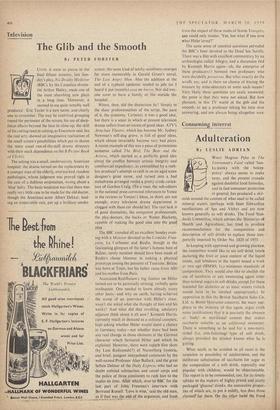Consuming interest
Adulteration
By LESLIE ADRIAN
WHAT Magnus Pyke in The Townsman's Food called 'han- ky-panky with the hokey: pokey' always seems to make news, and the present crusade against doubtful food formulas, and in fact consumer protection in general, has produced a skir- mish around the content of what used to be called mineral waters (perhaps with faint Edwardian recollections of Spa and Vichy) and are now known generally as soft drinks. The Food Stan- dards Committee, which advises the Ministries of Health and Agriculture, has tried to produce recommendations for the composition and description of soft drinks to replace those tem- porarily imposed by Order No. 1828 of 1953.
In keeping with approved and growing practice, the committee would like to see soft drink labels declaring the fruit or juice content of the liquid inside, and tabulates in the report issued a week or two ago (HMSO, Is.) minimum standards of composition. They would also like to abolish the use of saccharin or any sweetening agent other than natural sugars in soft drinks, except for those intended for .diabetics or as tonic waters (which would have to be labelled appropriately). In opposition to this the British Saccharin Sales Co. Ltd. (a Boots- Monsanto concern), the main sup- pliers to the industry of this agent, ,argue .(with some justification) that it is precisely the absence of 'body' or nutritional content that makes saccharin suitable as an additional sweetener. There is something to be said for a non-nutri- tional (i.e. non-fattening) 'type of soft drink, always provided the drinker knows what he is getting.
What needs to be avoided in, all cases is the suspicion or possibility of adulteration, and the deliberate substitution of saccharin for sugar in the composition of a soft drink, especially one popular with children, would be objectionable. The report is to be commended, too, for its timely rebuke to the makers of highly priced and nicely packaged 'glucose' drinks, the restorative proper- ties of which are, to put it mildly, less than those claimed' for them. On the other hand the Food Manufacturers Federation assert that medical opinion supports the makers' claims for this type of drink, in spite of the formidable evidence offered in Appendix B of the report.
A similar commotion is building up around the question of projected government regulations about the Proper description to be applied to 'filled milk' products. Filled milk is skimmed milk (centrifugally deprived of its natural fat) fortified with vegetable fats. The filled-milk manufacturers are under the impression that the Government wants to put them out of business to clear the way for the Milk Marketing Board. At least that is the suggestion made by L. E. Pritchitt and Co. Ltd. iq a pamphlet called Waste—By Order! which they have just published. This company, with branches in Greenwich and Newtownards, is anxious lest it should be compelled by statute to describe its products by such labels as 'Skim Milk with added Hydrogenated Ground Nut Oil,' thus describing the ingredients but not the treat- ment, e.g., pateurisation or homogenisation.
At this stage it would be unwise to take sides in this particular dispute, although one's sym- pathies naturally tend towards the natural rather than the artificial. It is true, nevertheless, that filled milk is not 'unnatural,' as its constituents seem to be quite wholesome and not synthetically derived.
The same cannot be said of some of the in- gredients listed in the current issue of the Ice Cream Industry Year Book. Filled milk does not appear under that name but skimmed milk is enthusiastically described as. 'an excellent basic ingredient for ice cream.' It contains usually 0.05 per cent, butterfat and about 9 per cent. MSNF (milk solids not fat). This is where the hanky- panky with the hokey-pokey starts, for milk (un- separated) or cream is conspicuous by its absence from mbst makes of ice-cream. It has been decided,. by the way, not to restrict the use of the term ice-cream but to identify two classes of pro- duct, 'dairy ice-cream' for an all-butterfat mixture and the old misleading name for the kind made up with vegetable fats. I do not think that this practice is general yet, but the Food Standards Committee made their recommendation as long ago as November, 1957.
The manufacture of ice-cream on the mass scale for public consumption under the infinitely variable conditions of the British climate is a very different matter from the making of ice-cream at home for immediate eating. Emulsifiers such as glyceryl monostearate are essential to the produc- tion of a smooth-textured ice-cream, such as the average consumer has come to expect (apparently the majority insist upon a light and frothy, or at
least a smooth, ice, rather as they expect a white, light-textured bread). In addition an ice-cream which is to be eaten out of a biscuit holder or a carton must have a high melting point, and the hardened fats provide this quality. Bulk is also provided by various stabilisers, either gelatins or seaweed derivatives such as agar, carrageen or Irish moss and sodium alginate, to name a few. In fact the composition of ice-cream is a highly technical matter, intelligible probably only to food chemists and related professions. If you do not believe this have a look at page 89 of the Year Book which offers both algebraic and arith- metical calculations for mix formulw.
Faced with such intricate matters, what hope does the ordinary consumer have of knowing whether what he buys and presumably eats and drinks is 'good' or tad'? If he discovers that glyceryl monostearate is considered to be non- toxic, he may sigh with relief, but I should be surprised if it made his mouth water.



































 Previous page
Previous page